New Guinea Impatiens cultivation methods and precautions: likes warmth and light
New Guinea Impatiens is a perennial herbaceous ornamental flower native to tropical mountains in Africa. It is also called the colorful Impatiens. New Guinea Impatiens has a wide variety of colors, including magenta, snow blue, white, purple, orange, etc. If the temperature is suitable, it can bloom all year round. This article introduces the cultivation methods and precautions of New Guinea Impatiens.
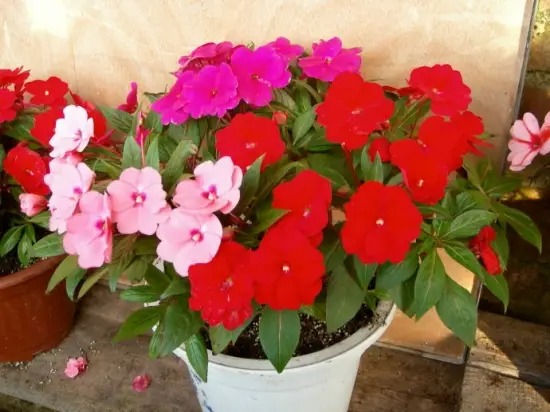
Flowering period of New Guinea Impatiens
The flowering period of New Guinea Impatiens is extremely long, and flowers can be seen almost all year round, but they bloom most in spring, autumn and winter, from around November to May .
The New Guinea Impatiens has a rich variety of colors, including white, pink, peach, vermilion, rose, orange, dark red, bronze, etc. The colors are bright and cheerful, the plant shape is plump and round, it blooms all year round, the flowering period is very long, and the leaf color and shape are unique. It is widely used in flower bed arrangements, hanging plantings, and year-round potted flowers, and new varieties appear every year.
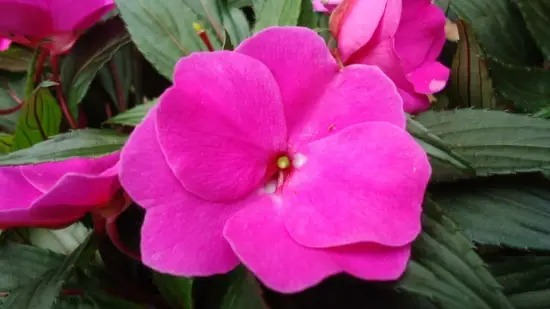
Cultivation methods and precautions of New Guinea Impatiens
1. Growth habits
New Guinea Impatiens likes warm and humid environment, is not cold-resistant and afraid of frost . The room temperature in winter should not be lower than 12 degrees. It requires coolness in summer, avoids exposure to the sun, and needs a little shade. It is not drought-resistant and afraid of water stains . In the rainy season, the drainage is poor and the ventilation is poor. It is easy to suffer from powdery mildew or cause the rhizomes to rot and even fall leaves. Pay attention to ventilation and lower the temperature .
New Guinea Impatiens is not very demanding on soil, but is sensitive to salt damage. It grows well in loose and fertile soil, with a soil mixture of 3 parts peat, 1 part sand, and 1 part garden soil, with a pH value of 5.5-6.5.
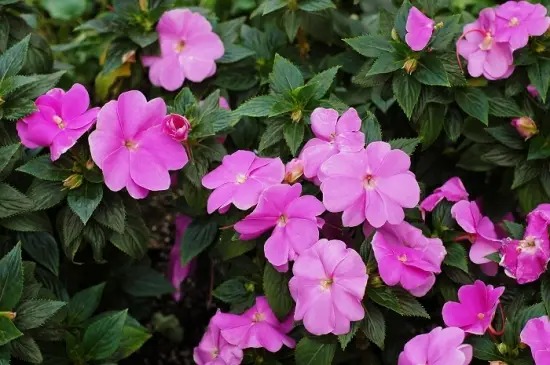
2. Daily maintenance focus
1. Temperature and light
New Guinea Impatiens likes warmth and plenty of light, is not cold-resistant, and avoids exposure to the sun. The suitable growth temperature is around 20 degrees. If it exceeds 25 degrees, the flowers will become smaller. If it exceeds 30 degrees, the relative humidity must be increased to keep the plant growing. When the temperature is relatively low, the plant's growth stops, and it will be damaged by frost when the temperature drops below 7 degrees.
2. Soil and moisture
New Guinea Impatiens likes moisture but is afraid of drought and waterlogging. Insufficient water can easily cause the flowers and leaves to fall off. It has strong adaptability to soil, and the pH value should be controlled between 5.5 and 6.5. It is advisable to use leaf mold, garden soil, and sand, mixed at a ratio of 5:3:2 to form a loose, fertile, and breathable sandy culture soil. The pot should not be too large. The pot soil should be wet when it is dry, and water should be poured when it is dry. Waterlogging will cause root rot, and too dry will cause branches and leaves to wither. The most important part of home maintenance is to maintain a certain air humidity, and it is advisable to spray water on the plants frequently.
3. Fertilizer
New Guinea Impatiens New Guinea Impatiens has a long flowering period and usually requires more nutrients. Nitrogen fertilizer can be applied appropriately during the seedling stage. Nitrogen, phosphorus and potassium compound fertilizer should be applied once every 10 to 15 days during the growth period and flowering period. Avoid applying nitrogen fertilizer alone, otherwise there will be more leaves and fewer flowers. If fertilizer is accidentally stained on the leaves during fertilization, spray water to wash it off in time.
4. Reproduction
The germination ability of New Guinea Impatiens is relatively strong, and it is easy to root by cuttings. Break off the branches from the base, cut off 1-2 leaves at the base of the branches, put them in clean water for 15-30 minutes to allow the branches to absorb enough water, and then insert them into the substrate. Either plain sand or vermiculite can be used as the cutting substrate. New roots will be produced in 5-6 days. After 2 weeks, when the roots are 2-3 cm long, they can be potted.
5. Pest and disease control
The New Guinea Impatiens plants grow robustly and have strong resistance to diseases and insect pests. So far, no major epidemic diseases and insect pests have been found. Only stem rot occasionally occurs during cuttings. Regular spraying of fungicides can play a preventive role. Strengthening ventilation management can reduce the damage caused by aphids and red spiders. Once found, kill them immediately with insecticides.
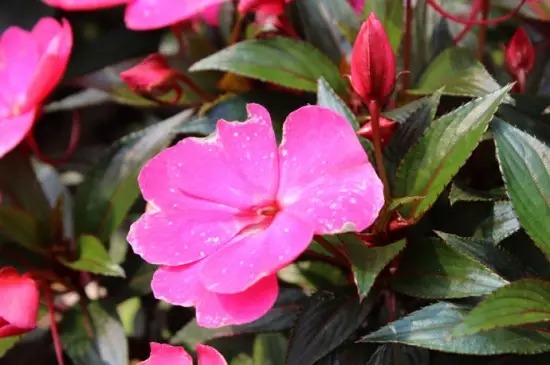
Cultivation Techniques of Impatiens New Guinea
How to propagate New Guinea Impatiens:
There are three methods: sowing, tissue culture, and cuttings.
1. The sowing and propagation time is generally from March to April. Harvest in time and sow immediately after harvesting. The optimum temperature for germination is 22 degrees.
2. The tissue culture propagation method has been successful and large-scale production has begun.
3. In production, because the self-pollination ability of New Guinea Impatiens is poor and the tissue culture cost is high, cuttings are often used for propagation. The best season for cuttings is spring, summer and early autumn, and it can be propagated all year round in the greenhouse. Cuttings can be directly taken from the young shoots between the leaf axils for micro-cuttings, and the propagation speed is quite fast; you can also cut the branches of the current year into several sections, each with 2-3 sections. The cutting medium can be plain sand or vermiculite. In order to increase the rooting rate of cuttings, the cuttings are quickly dipped in ABT rooting powder, and new roots will be produced in 5-6 days. After 2 weeks, when the roots are 2-3cm long, they can be potted.
The suitable temperature for the cultivation of New Guinea Impatiens is 16-24 degrees. Temperatures below 15 degrees or above 32 degrees will affect normal growth, and the light requirement is 30,000-50,000 Lx. New Guinea Impatiens needs to be carefully managed, and watering should be based on the principle of "see dry and see wet". Spray foliar fertilizer every 7-10 days or apply fermented thin fertilizer water every half a month, and its growth will be more gratifying. 2-3 weeks after planting, when the seedling height reaches 10-15cm, apply 0.5g/L of compound fertilizer in small amounts and multiple times. If there are too many nutrients, the leaves will have brown spots. The nitrogen content of the fertilizer should be controlled at 50-100mg/L. When the light is strong, the flowers bloom early and small. At this time, it is necessary to frequently pinch the top to accumulate nutrients to promote side branches and make the plant shape fuller.
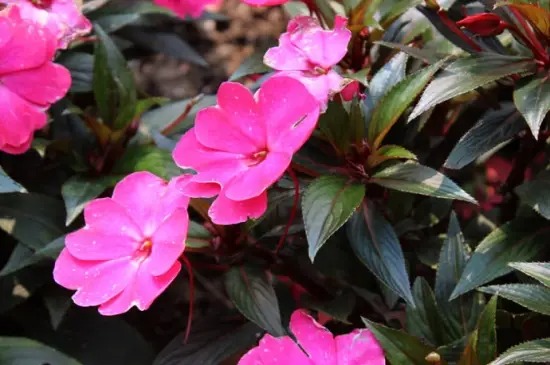
Differences between New Guinea Impatiens and African/Sudanese Impatiens
New Guinea Impatiens is a perennial herbaceous ornamental flower of the Impatiens genus, the Balsamaceae family . It is native to tropical mountains in Africa. This species is the latest dwarf variety successfully cultivated in Japan. The plant is 25-30cm tall, with fleshy, smooth, green or reddish brown stems, prominent stem nodes, and easy to break. The leaves are whorled, lanceolate, with sharp serrations on the edges, and the leaf color is yellow-green to dark green. The color of the veins and stems is often related to the color of the flowers. The flowers are solitary in the leaf axils (occasionally two flowers are born in the leaf axils), and the petals at the base are derived into a rectangle. The flower colors are extremely rich, including magenta, snow blue, white, purple, orange, etc.
Impatiens africana is an evergreen perennial subshrub . The whole plant is fleshy and hairless. The stem is thick, smooth, multi-branched, green, with prominent nodes and easy to break. The leaves are single and alternate, and the leaves on the upper part of the stem are whorled, ovate-lanceolate, pointed at both ends, with blunt serrations on the leaf margins, and the leaf color is light green to dark green. The flowers are solitary or clustered in the axils of the leaves, and the base of the petals is derived into a rectangle. The flower colors are extremely rich, including magenta, snow blue, white, purple, orange, and complex colors. The capsule is about 1 cm long; the seeds are small, about 1750 seeds per 1g and about 7000 seeds per 10ml.